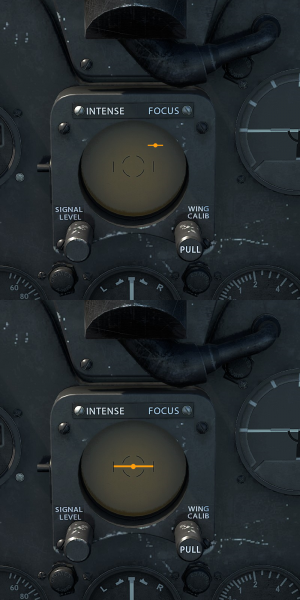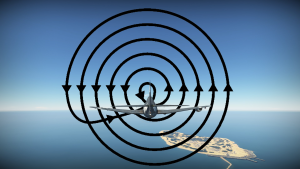AN/APS-6
Contents
Description
The AN/APS-6 is an American airborne target detection (search) radar with tracking capability. It was used on nightfighters and in the game is found on the F6F-5N.
Vehicles equipped with this radar
General info / usage
The AN/APS-6 is primarily a target detection radar however it does have a limited tracking capability. The radar has a theoretical maximum detection range of 60 km, however, in reality, air targets will nearly always only be detected at much shorter distances (historically at long ranges the radar was mainly used to detect land masses).
The radar operates in a "Spiral Scan" search pattern, where the radar dish spins rapidly scanning the area in front of the aircraft following a spiral path (see image to the right). As a result of this, the radar appears to spin very rapidly (in real life 20 times a second) on the radar display, however, targets are not updated on every pass as the radar is pointing at a different angle on each pass. Likewise depending on whether the radar is pointing towards the outside of the spiral or towards the centre the effect of ground clutter is different, making it appear to "pulse" on the radar display.
The radar can lock on to and track targets within a narrow cone out to a maximum range of 1 km; however, in order to do this, the radar must cease scanning. This function mimics the gun aiming mode found on the real radar. At short range, the radar could be switched to gun aiming mode where a circle was displayed on the radar display and the pilot manoeuvred their aircraft to position the radar return within the circle (this ensured their guns were pointed at the target). The radar would then indicate to the pilot once the range had closed to that of the guns convergence, allowing the pilot to hit the target.
| Features | ||||||
|---|---|---|---|---|---|---|
| Band | Pulse mode | PD mode | MTI mode | IRST mode | TWS mode | SARH |
| I | ✓ | X | X | X | X | X |
| Search characteristics | ||||||
|---|---|---|---|---|---|---|
| Mode | Max range | Effective range | Display ranges | IFF | ||
| SRC | 60 km | 7.2 km | 2 km, 9 km, 46 km, 120 km |
✓ | ||
| Search modes | ||||||
|---|---|---|---|---|---|---|
| Mode | Scan type | Azimuth | Elevation | Period | ||
| SRC | One-way raster | ±60° | ±30° | 1.2 s | ||
| Tracking characteristics | ||||||
|---|---|---|---|---|---|---|
| Mode | Max range | Azimuth limit | Elevation limit | |||
| TRK | 1 km | ±15° | ±15° | |||
Comparison with analogues
Compared to other wartime radars the AN/APS-6 has good scanning angles and an OK range. Compared to the AN/APG-26 the tracking angles of the AN/APS-6 are poor, although better than those on the RP-5. The tracking range is far inferior to both the AN/APG-26 and RP-5.
Pros and cons
Pros:
- Decent range
- Can track targets
- OK horizontal scanning angles and very good vertical scanning angles
Cons:
- Inferior range and scanning angles to some high tier radars
- Tracking capability is limited
History

The AN/APS-6 was manufactured by the Westinghouse Electric Corporation, designed for use on carrier-based night fighter aircraft. Work on the radar began in April 1943 with production estimated to start at the beginning of 1944. By September 1043 it was becoming clear that the production target would not be met due to problems arising with Westinghouse's RF head; in order to begin production, it was decided to reuse the RF head from the earlier "ASD" radar. The first of these radars designated AN/APS-6A, began rolling off the production line in March 1944; with the AN/APS-6 (with the new RF head) entering production in September 1944.
The radar weighed 242 lbs (110 kg) and in its normal search mode operated in a spiral scan pattern (see image at the top of the article). In order to scan this way a 400 W, 6,000 rpm spun the radar dish around its longitudinal axis (the axis parallel with the centerline of the aircraft) through a reduction gearbox meaning that the radar dish span at 1,200 rpm (20 revolutions a second). As it span the radar dish was made to "nod" back and forth 60° in each direction, which combined with the spinning produced the spiral pattern and allows the radar to scan a 120° (60° in each direction) cone in front of the aircraft.
The radar's primary display was "B-scope" (a rectangular top-down display where the distance from the bottom of the display gives the range, and the distance from the centre line the azimuth, of a target), which provided different function at different ranges. At the 65-Mile & 25-Mile range settings, the radar could return large surface contacts such as ships as bright dots on the radar display and would show land masses as large filled in areas on the display. It was possible to detect air targets on the 25-Mile setting. The 5-Mile & 1-Mile range settings were primarily used for detecting aircraft. At these range settings, the B-scope transitioned into an H-Scope; a type of B-scope where each target is returned as two dots next to each other, where the left-hand dot is the position of the target and the right-hand dot's position relative to the left-hand dot gives the elevation of the target. In these two settings, a horizontal bar could also be displayed across the screen, displaying the altitude of the aircraft (allowing it to function as a form of radar altimeter).
A final mode of the radar was the "Gun-Aim" mode; in this mode, the B-scope display was replaced with a G-scope, a type of C-scope. In this mode the radar stopped using spiral scan, switching to a conical scan where the radar dish was locked at a slight angle and continued spinning, as a result, the radar scanned a narrow cone in front of the aircraft. A circle and a pair of vertical lines would be displayed on the radar screen and targets would be displayed as dots where their distance from the centre of the circle showed their azimuth and elevation relative to the radar. The radar return had a horizontal line passing through it which grows in length as the target gets closer. The pilot would manoeuvre the aircraft to position the target in the centre of the circle, they would then close in on the target until the horizontal line grew to a point where it was touching the two vertical lines. At that point, the pilot would fire the guns in order to hit the target. This is the display mode statically modelled on the radar display in the cockpit of the F6F-5N in-game; in the image to the right radar returns have been added to the display to demonstrate it's operation.
Media
Excellent additions to the article would be video guides, screenshots from the game, and photos.
See also
- RP-5 (another radar with combined search and track functions)




